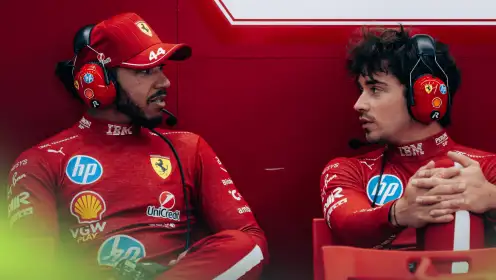They weren’t shouted by a rookie still learning the ropes. They came from Charles Leclerc, Ferrari’s brightest hope, fresh off a flawless pole position at the Hungarian Grand Prix. For fans, it was meant to be the start of a redemption arc — a chance for the Scuderia to steady a chaotic season. Instead, it became one of the most revealing implosions in recent Ferrari history, playing out in real time for millions.
Leclerc wasn’t alone in his dismay. Seven-time world champion Lewis Hamilton, in his debut year in red, found himself battling the same sinking feeling. For a team that once embodied dominance under Michael Schumacher, the sight — and sound — of its two superstar drivers questioning its competence was almost unthinkable.
This wasn’t just a bad race. It was a Formula 1 crisis, triggered by hesitation, sealed by misjudgment, and amplified by leaked team radio that stripped away Ferrari’s carefully managed public face.

A Weekend Poised for Redemption
The Hungarian Grand Prix was never supposed to be just another round on the calendar. For Ferrari, it was framed as a reset — a chance to wipe clean the blunders of the season’s first half, which had been marred by poor strategy calls, underwhelming upgrades, and internal tension in Maranello.
Qualifying seemed to confirm that narrative. Leclerc delivered a masterclass lap, snatching pole from Max Verstappen, Lando Norris, and George Russell. It was precise, aggressive, and effortless — a reminder of why he’s regarded as one of the most naturally gifted drivers on the grid. Ferrari fans, the Tifosi, felt the old magic stirring. The scarlet car was at the front again, and their number one driver had a golden opportunity to control the race from the start.
But in Formula 1, hope can vanish faster than a pit stop gone wrong.
Hesitation at the Front
At lights out, Leclerc launched cleanly and held position, but the threats loomed immediately. McLaren’s pace was fierce, and Red Bull was already thinking strategically. In races like Hungary, where overtaking is notoriously difficult, the key to victory is defending track position and reacting decisively to rivals’ moves.
Ferrari didn’t react.
As other teams pitted early to cover the undercut, Leclerc was left out on degrading tires for lap after lap. His grip faded, his lap times dropped, and the advantage he’d built began to evaporate. Over the radio came his first warning — part frustration, part inevitability: “We’re going to lose this race with these tyres.”
No change came. And then, the moment that defined the weekend: “You just had to listen to me.”
It wasn’t rage. It was the sound of a driver who had delivered everything asked of him, only to watch it unravel because the people he trusted most didn’t act. Pole position turned to P4, but the damage went deeper — a fracture in the trust between driver and pit wall.

Frustration at the Back
While Leclerc’s race was slipping away at the front, Hamilton was fighting a different, equally demoralizing battle from P12 on the grid. The seven-time champion needed boldness — an early stop, a daring tire call, something to disrupt the midfield train ahead.
It never came.
Lap after lap, Hamilton sat bottled behind slower cars, his tone on the radio calm but resigned: “Bit of a sitting duck behind these guys.” It was the voice of a champion left without the tools to fight, watching opportunity fade into the distance.
For Hamilton, this wasn’t just about one afternoon in Budapest. It was a warning that Ferrari’s long-standing strategic hesitations could haunt his tenure in red before it’s even truly begun.
When the World Hears What You Don’t Want Heard
What made this race more explosive was that the world didn’t just see the result — they heard the process. The leaked Ferrari radio was raw, uncensored, and stripped of the diplomatic tone usually heard on broadcast feeds. Leclerc’s words dripped with betrayal. Hamilton’s, with quiet defeat.
It was a rare glimpse into Formula 1 without the filter — a reminder that behind the corporate polish, this is a sport of immense pressure, fragile trust, and high-stakes decision-making. And when that trust falters, it’s impossible to hide.
Social media lit up. Fans dissected every syllable. Pundits debated whether Ferrari’s issues were down to flawed strategy teams, risk-averse calls, or a culture that avoids decisive leadership in crunch moments.
The Anatomy of a Tactical Collapse
On a track like the Hungaroring, the winning strategy is simple: cover the undercut, defend your position, and force rivals to react. Ferrari’s hesitation at each key moment flipped that formula on its head. Rivals like Red Bull and McLaren executed with precision; Ferrari was always a lap late, a decision short, and unwilling to gamble when it mattered.
The result? Leclerc’s hard-earned track position was gone, Hamilton’s race never came alive, and Ferrari handed control to their competitors without a fight.
Patterns, Not Isolated Incidents
What happened in Hungary wasn’t new. Ferrari has a long recent history of botched strategy calls, slow reactions, and missed opportunities. But rarely has it been so publicly exposed.
For Leclerc, the question is whether the team is even sticking to agreed pre-race plans. For Hamilton, the fear is that this might be more than teething problems — that Ferrari’s structural weaknesses will prevent him from returning to title contention.
A slow car can be fixed. A botched pit stop can be overcome. But when a team loses its drivers’ trust, every instruction becomes suspect, every call a potential point of conflict.
The Crossroads at Maranello
The fallout could be seismic. Behind closed doors, it’s hard to imagine Leclerc or Hamilton simply moving on. Both could demand greater control over strategy, refusing to follow pit wall instructions they no longer believe in. Hamilton, still new to the project, may already be questioning the long-term viability of his Ferrari gamble.
For the team, the pressure is immense. Fans and commentators are openly discussing whether Ferrari needs to reshuffle its decision-making structure before the summer break. Change, they argue, isn’t just desirable — it’s urgent.
Because if Ferrari continues down this path, the risk isn’t just losing races. It’s losing the faith of two of the most talented drivers in the sport — a loss from which recovery could take years.
The Verdict
Hungary was meant to be Ferrari’s reset. Instead, it may be remembered as the breaking point — the weekend where trust snapped, frustrations spilled into public view, and the most iconic team in motorsport was forced to confront uncomfortable truths.
The questions now are brutally simple: Should Ferrari overhaul its strategy leadership before the next race? And after Budapest, can Leclerc and Hamilton ever fully trust the pit wall again?
Because in Formula 1, trust is as valuable as horsepower. And once it’s gone, there’s no easy way back.
Full Video:






